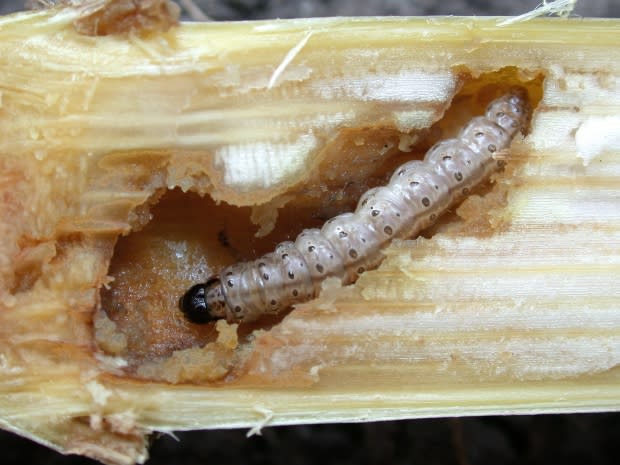Corn crops in Nova Scotia under attack from European pest
In what could be a first worldwide, researchers say a pest that decreases the yield and quality of corn crops is now showing resistance to a protein found in a hybrid corn grown on some Nova Scotia farms.
The European corn borer is a moth native to Europe that was first reported in North America in 1917. Since 1996, corn farmers have planted Cry1F (Herculex I), the first genetically modified corn crop ever, to kill the European corn borer.
But in Nova Scotia, the borer has developed a resistance to Cry1F.
"This could be the first documented case in the world," said Sonny Murray, a field crop specialist in Nova Scotia.
Last fall, researchers from the University of Guelph in Ontario collected larvae from five independent fields in Nova Scotia after corn growers reported unexpected crop damage.
Findings haven't been published or peer reviewed
The researchers took the samples back to the lab and exposed it to the toxin. They found the insect survived without any trouble.
Four of the fields were in Truro and the fifth was in Kingston. The two communities are about 140 kilometres apart as the crow flies.
The researchers' findings have not yet been published or subjected to peer review.

Despite the name, the European corn borer doesn't just chow down on corn. It damages more than 40 acceptable hosts, including peppers, potatoes, peas and beans.
The larvae damage crops by chewing a tunnel into the plant. For the affected corn cobs, it looked like a hole was drilled into them. The larvae later turns into a moth, flies away and lays more eggs on acceptable hosts that are lush and young.
Why resistance was 'inevitable'
Corn farmers whose fields were struck by the European corn borer were planting the same hybrid and using it year after year.
Art Schaafsma, a University of Guelph field crop pest management professor, said it was "inevitable" a resistance would develop.
"One of the things that you worry about when you grow these crops is the insect is quite elastic in its genetics, and it can develop resistance to that control strategy," he said. "That is what we have discovered in Nova Scotia."
How much the borer decreases corn yields
Murray said the European corn borer lowers corn yield by about 12 per cent.
"The growers will still grow corn and they will still get a crop, but it will affect yield and quality and profitability," he said.
Murray said testing will continue this summer to determine whether the resistant pest has spread to areas in Prince Edward Island and New Brunswick.
Josh Oulton is the owner and operator of TapRoot Farms in Port Williams, N.S., which grows organic sweet corn. He doesn't use Cry1F, but the European corn borer's potential resistance to it worries him.
"To me, it's a sign that this technology is soon not going to work. We're on a slippery slope now. And yes, we can rotate for a few years, but after awhile that rotation is not going to work," said Oulton.

"It's just an example of nature saying, 'Screw you, humans, you can't control me.'"
The resistance can be overcome if farmers combine different corn hybrids when they plant their crops, suggests the Canadian Corn Pest Coalition.
In Atlantic Canada, 137,500 tonnes of corn were produced in 2017, with Nova Scotia having the largest production in the region at 61,500 tonnes, shows data from Agriculture and Agri-Food Canada.
Corn fields in Nova Scotia are also the leading grain crop grown by area in the province, said Statistics Canada.
MORE TOP STORIES
